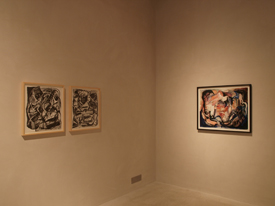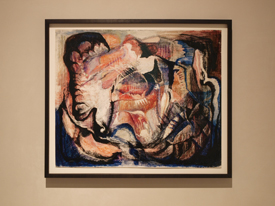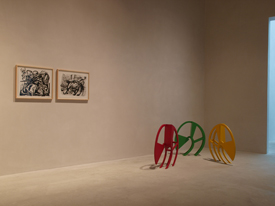2010 Georg Baumgarten
6 January – 17 May 2010
Georg Baumgarten – Works from around 1933
Cabinet Exhibition Room 20
Georg Baumgarten (1894-1945) covered up his life as an artist – or perhaps we should rather say he made it possible this way – by working as a soap salesman, insurance representative, and clerk. When, together with his wife and daughter, he died in April 1945 during the last air raids on Berlin, he was yet unknown. His son Claudio, born in 1919, gathered all of the works together that the artist had been storing outside of the city, and turned to William Wauer, among others, who belonged to the inner circle of artists associated with Herwarth Walden’s Der Sturm Gallery. The program of the Der Sturm Gallery had greatly influenced Baumgarten. As of 1913, the circle compositions of Robert Delaunay and the pictorial staccato of the Italian Futurists constituted the formal basis of a synthesis of mythological, individual, and cosmological themes that identify Baumgarten as a proto-Expressionist, as indicated in the group of works on display here that were made around 1933. Dina Baumgarten, his daughter-in-law managed to keep the estate together, turning it over to Kolumba in 2006.
Georg Baumgarten – Works from around 1933
Cabinet Exhibition Room 20
Georg Baumgarten (1894-1945) covered up his life as an artist – or perhaps we should rather say he made it possible this way – by working as a soap salesman, insurance representative, and clerk. When, together with his wife and daughter, he died in April 1945 during the last air raids on Berlin, he was yet unknown. His son Claudio, born in 1919, gathered all of the works together that the artist had been storing outside of the city, and turned to William Wauer, among others, who belonged to the inner circle of artists associated with Herwarth Walden’s Der Sturm Gallery. The program of the Der Sturm Gallery had greatly influenced Baumgarten. As of 1913, the circle compositions of Robert Delaunay and the pictorial staccato of the Italian Futurists constituted the formal basis of a synthesis of mythological, individual, and cosmological themes that identify Baumgarten as a proto-Expressionist, as indicated in the group of works on display here that were made around 1933. Dina Baumgarten, his daughter-in-law managed to keep the estate together, turning it over to Kolumba in 2006.


